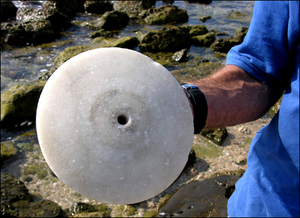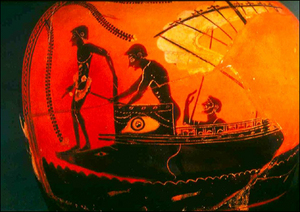
|
| ©Israel Antiquities Authority |
| Relic of ancient mariner's talisman |
An Israeli lifeguard stubbed his foot during an underwater morning swim in an offshore archaeological site this week on what turned out to a surprising rare find.
Instead of treading on one of dozens of slippery giant stingrays which regularly invade Israeli coastal waters during July and August, David Shalom discovered the relic of a 2,500 year-old mariner's talisman which he presented to the Israel Antiquities Authority (IAA).
Kobi Sharvit, director of the IAA's Marine Unit identified the 20 centimeter wide marble stone which was flat on one side and convex on the other, as a talisman or ophtalmoi by its Greek name dating to the fifth or fourth century BCE. It represented the pupil of an eye affixed with a bronze nail by to the bow of a ship to protect ancient mariners from the evil spirits.
But lying hundreds of years on the ocean bed the salt water had washed away the eye painted on the stone and erased its engraved lines.
"We know from decorated pottery vessels, pithoi and ancient coins that this model was very common on the bows of ships designed to protect them from the evil eye and envy. It was also meant as a navigation aid to act as a pair of eyes that looked straight ahead to warn of approaching reefs and other dangers," Sharvit said.

|
| ©British Museum |
| Athenian example of mariner's talisman depicted on ceramic jar |
To this day modern boats in Portugal, Malta, Greece and even in the East Asia commonly use this form of decoration, Sharvit noted.
Only four of such common ancient artifacts have been found in the Mediterranean Sea. Two were recovered from ancient cargo vessels shipwrecked along Turkey's western coast between the islands of Samos and Chios at the site of Tektas Bumu, Sharvit explained. The other two finds were made off the Israeli coast, one near Haifa and the second now at Yavne south of Tel Aviv.
Yavne was an ancient port city first settled in the Middle Bronze Age and continuously inhabited until the Middle Ages. The port was a hub of commercial activity.
Many ships were wrecked here, hurled onto the reefs by stormy seas. Among the artifacts discovered in archaeological surveys since the 1980s, were anchors of all sizes, fishing equipment, lead connectors and stone plombs. Other items included household and kitchen utensils such as lead cooking ovens, grindstones, stone bowls, storage jars, amphorae and cook pots dating from the late Bronze Age, Persian, Hellenistic, Roman, and Byzantine periods.
These were not the only finds. Pottery shards of vessels manufactured in Israel and throughout the Mediterranean have been retrieved from the sea, as well as various pieces of gold jewelry, hematite seals, bronze arrowheads, axes and two small statues of Ba'al, the chief Phoenician and Caananite god.



Reader Comments
to our Newsletter